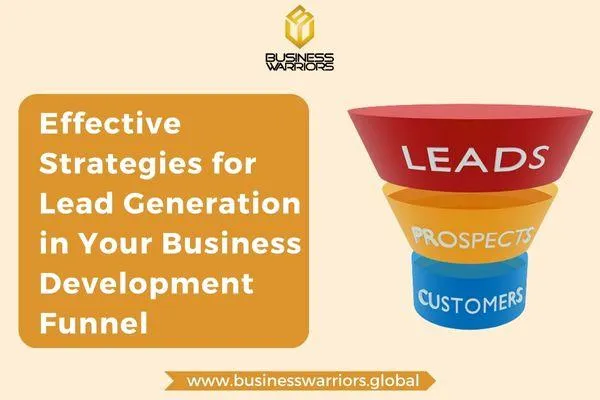
Effective Strategies for Lead Generation in Your Business Development Funnel
in today's highly competitive business landscape, lead generation plays a pivotal role in driving growth and revenue. To effectively attract and convert potential customers, businesses need to implement strategic lead generation strategies within their business development funnel. In this article, we will explore effective strategies that can help you generate quality leads and maximise the potential of your business development funnel.
I. Understanding Your Target Audience

A. Identifying your ideal customer profile
Before diving into lead generation, it is essential to have a clear understanding of your target audience. Identify your ideal customers' characteristics, preferences, and pain points to tailor your lead generation efforts accordingly.
B. Conducting market research to understand customer needs and pain points
Thorough market research is crucial for gaining insights into your customers' needs and pain points. By understanding their challenges and motivations, you can develop effective lead-generation strategies that resonate with their interests.
C. Creating buyer personas to guide your lead generation efforts
Developing buyer personas allows you to create a detailed profile of your target customers. These personas act as fictional representations of your ideal customers, helping you personalise your marketing messages and improve lead generation results.
II. Content Marketing for Lead Generation
A. Developing high-quality and relevant content
Content marketing is a powerful tool for lead generation. Create informative, valuable, and engaging content that addresses the pain points of your target audience. By providing solutions and insights, you establish credibility and attract potential leads.
B. Utilising various content formats (blogs, videos, infographics, etc.)
Diversify your content formats to cater to different preferences. Alongside blog articles, consider incorporating videos, infographics, podcasts, and interactive content. This variety increases engagement and attracts a broader audience.
C. Optimising content for search engines to attract organic traffic
Implement search engine optimisation (SEO) techniques to enhance the visibility of your content. Conduct keyword research to identify relevant keywords and incorporate them naturally into your content. This optimisation increases organic traffic and improves lead generation opportunities.
III. Landing Pages and Lead Magnets

A. Designing compelling landing pages to capture leads
Create visually appealing and user-friendly landing pages that grab visitors' attention. Use persuasive copywriting, clear call-to-action buttons, and a streamlined layout to encourage lead capture and conversions.
B. Creating valuable lead magnets (e-books, whitepapers, webinars, etc.)
Offer valuable incentives, and lead magnets, to entice visitors to provide their contact information. E-books, whitepapers, webinars, and exclusive content are examples of lead magnets that provide value to potential leads.
C. Implementing effective lead capture forms on landing pages
Strategically place lead capture forms on your landing pages to collect contact information from interested visitors. Keep the form simple and minimise the number of fields to optimise conversion rates.
IV. Email Marketing and Nurturing
A. Building an email list through opt-in forms and subscriptions
Utilise opt-in forms and subscription options across your website and landing pages to build an email list. Encourage visitors to sign up by offering exclusive content, promotions, or updates.
B. Designing personalised email campaigns to nurture leads
Craft personalised email campaigns that nurture leads throughout their customer journey. Segment your email list based on interests and engagement levels to deliver tailored content that builds trust and drives conversions.
C. Segmenting leads based on their interests and engagement levels
Segment your leads based on their behaviour, interests, and engagement with your content. This segmentation enables targeted communication, ensuring that leads receive relevant information and offers.
Remember, effective lead generation requires continuous testing, optimisation, and adaptation to market trends. By implementing these strategies, you can generate quality leads and propel your business growth through a well-defined business development funnel.
Conclusion
In conclusion, lead generation is an essential component of a successful business development funnel. By understanding your target audience, leveraging content marketing, optimising landing pages, utilising email marketing, and implementing other effective strategies, you can attract and convert high-quality leads. Regularly monitor and analyse your lead generation efforts, make data-driven decisions, and adapt to changing market dynamics. With a well-executed marketing funnel strategy, your business can thrive and achieve sustainable growth.




